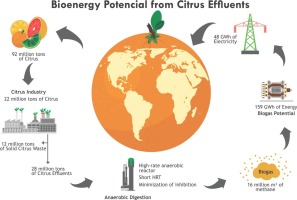Journal of Cleaner Production ( IF 11.1 ) Pub Date : 2020-01-13 , DOI: 10.1016/j.jclepro.2020.120128 E.S. Rosas-Mendoza , J.M. Méndez-Contreras , A.A. Aguilar-Lasserre , N.A. Vallejo-Cantú , A. Alvarado-Lassman

|
At the global level, citrus production is around 92 million tons and citrus processing is about 22 million tons generating 28 million m3 of Citrus Effluents. In the last two decades, the generation of wastewater by the citrus industry has increased, and since earlier studies have focused mostly on solid citrus waste, there is inadequate information related to the potential energy value of these effluents. The main contribution of this work is the development of a methodology for conducting an energy analysis to determine the amount of electrical energy that can be derived from the biogas produced in the anaerobic digestion of citrus effluents at the global level. This determination was made through the operation of a novel, high-rate reactor, called the Anaerobic Hybrid Reactor. The aim of this paper was to evaluate the bioenergy potential of the effluents from the citrus industry by using anaerobic digestion to generate electrical energy. As part of the results of this evaluation, it was found that one ton of processed oranges generates 1.25 m3 of citrus effluents, 0.72 m3 of methane at standard temperature and pressure, 7.16 kWh of gross electricity, and 2.15 kWh of net electricity, which represents a cost of 0.17 USD. The worldwide bioenergy potential from citrus effluents by the main citrus processing countries is approximately 16 million m3 of methane/year at standard temperature and pressure, which is equivalent to approximately 159 GWh of gross electricity per year, about 48 GWh of net electricity per year, and about 111 GWh of thermal energy per year. The biogas that is produced can replace as much as 9% of the consumption of fuel oil and natural gas used in a citrus processing plant. Anaerobic digestion is a clean, simple energy technology, and it helps to minimize the social, environmental, and economic problems caused by poor management and the lack of alternatives for the treatment of the effluents from the citrus industry.
中文翻译:

通过厌氧消化评估柑橘废水中的生物能潜力
在全球范围内,柑桔产量约为9200万吨,柑桔加工量约为2200万吨,产生2800万立方米3柑橘废水。在过去的二十年中,柑桔工业产生的废水有所增加,并且由于较早的研究主要集中在固态柑桔废物上,因此与这些废水的潜在能量价值相关的信息不足。这项工作的主要贡献是开发了一种进行能量分析的方法,以确定可以从全球范围内的柑桔废水厌氧消化中产生的沼气中提取的电能量。该确定是通过运行新型高速率反应器(称为厌氧混合反应器)进行的。本文的目的是通过厌氧消化产生电能来评估柑桔工业废水的生物能潜力。作为评估结果的一部分,3种柑橘废水,在标准温度和压力下为0.72 m 3的甲烷,7.16 kWh的总电力和2.15 kWh的净电力,这意味着成本为0.17美元。从主要的柑橘加工柑橘国家废水中的全球生物能源潜力约为1600万米3在标准温度和压力下,每年的甲烷排放量相当于每年总电力159 GWh,每年净电力约48 GWh,每年热能约111 GWh。产生的沼气可替代柑桔加工厂消耗的燃油和天然气的9%。厌氧消化是一种清洁,简单的能源技术,它有助于最大程度地减少因管理不善和缺乏用于处理柑橘类工业废水的替代品而造成的社会,环境和经济问题。



























 京公网安备 11010802027423号
京公网安备 11010802027423号